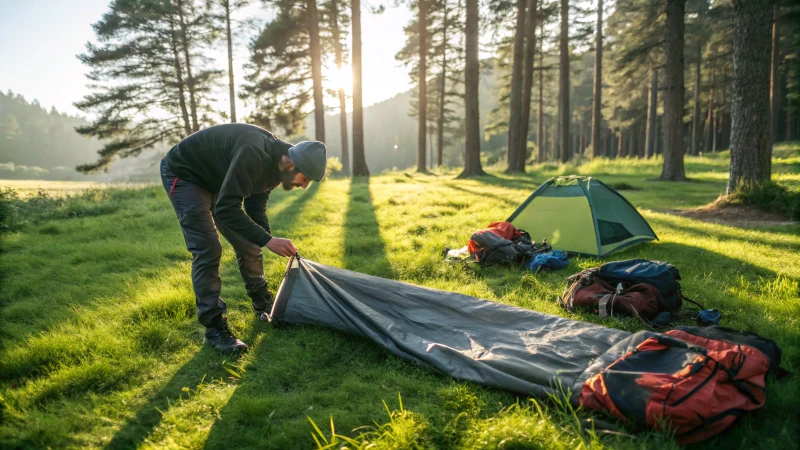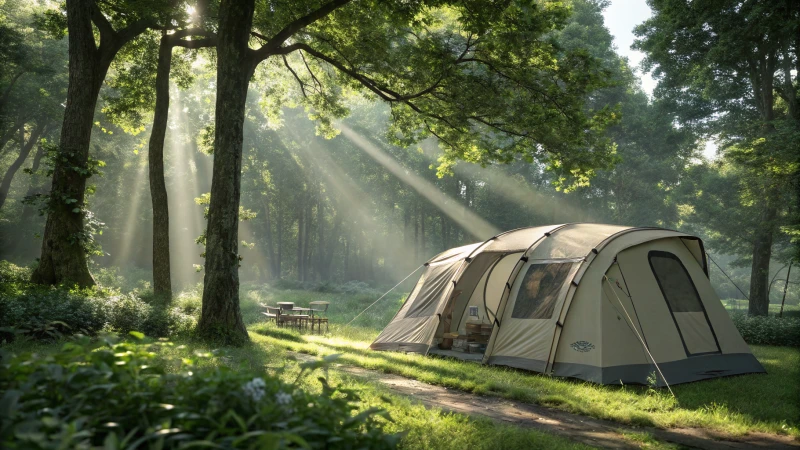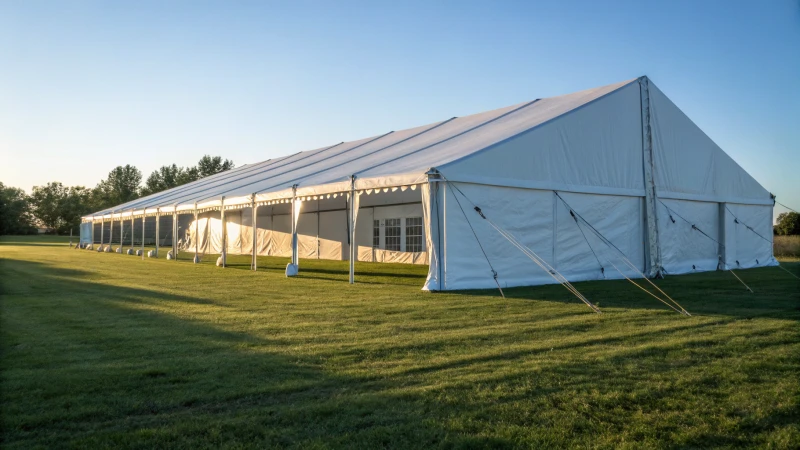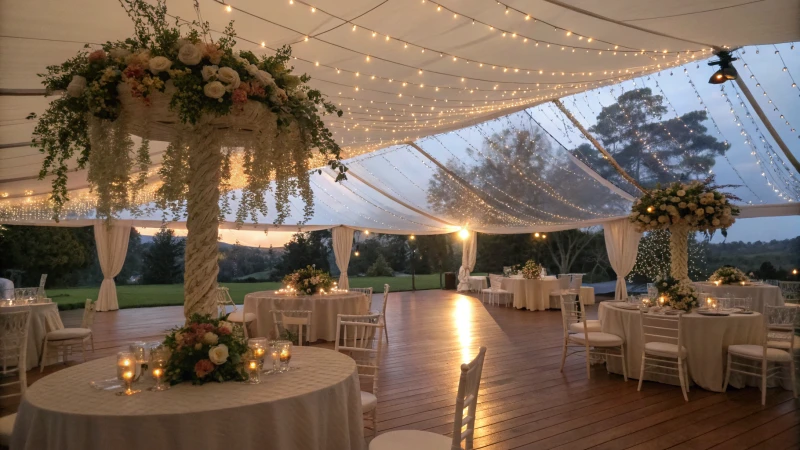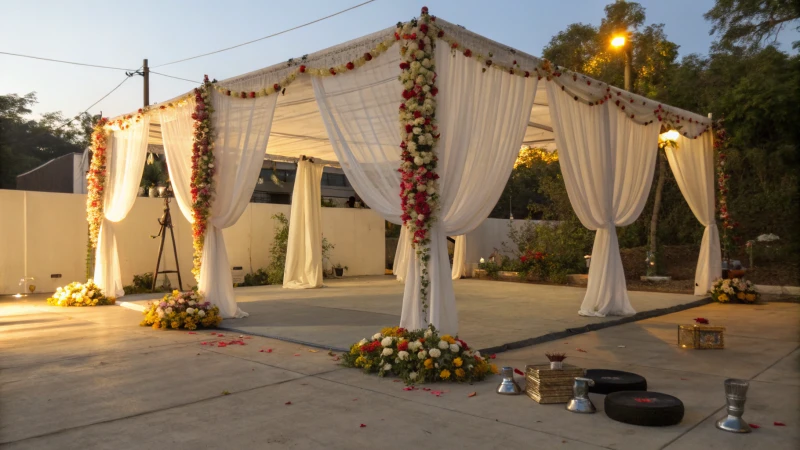
Organizing a wedding on concrete might sound tricky, especially with tent setup challenges.
To set up a wedding tent on a concrete slab, I use steel anchors, expandable bolts, or weight plates. These techniques keep the tent secure without harming the surface, making sure everything stays put throughout the celebration.
Setting up on concrete can initially feel overwhelming. But, trust me, once you understand the pros and cons of each anchoring option, it gets easier. Each method offers its unique benefits and potential drawbacks, so it’s crucial to consider the specifics of your event and location.
For instance, there was this one wedding I organized where the venue was a beautiful urban rooftop with a concrete floor. Initially, I was at a loss. But once I got familiar with these anchoring techniques, I was able to ensure that the tent was not only secure but also added to the aesthetic of the setting. With the right approach, your wedding tent can stand strong and look amazing too!
Steel anchors can damage concrete slabs.False
Steel anchors are designed to secure tents without damaging the surface.
Weight plates are a non-invasive anchoring method.True
Weight plates provide stability without penetrating or damaging the surface.
What Are the Pros and Cons of Using Steel Anchors?
Ever stood in a hardware store, pondering whether steel anchors are your best bet for that big project? I’ve been there too.
Steel anchors boast impressive tensile strength and corrosion resistance, perfect for heavy-duty tasks. But beware—they’re tricky to install and might damage surfaces like concrete.
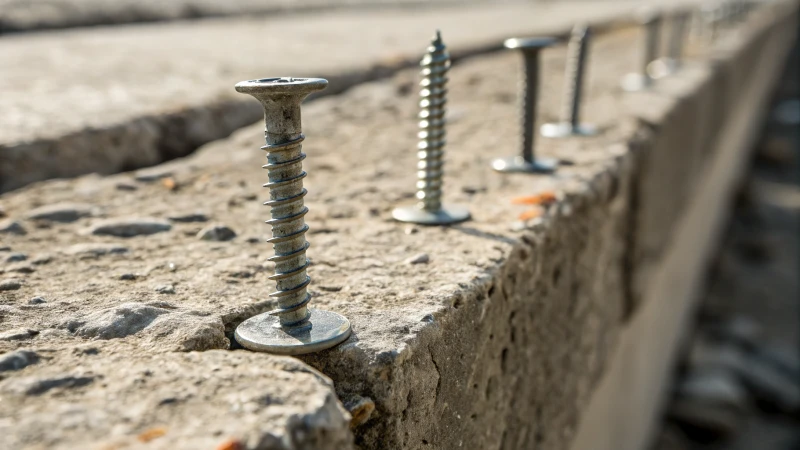
Advantages of Steel Anchors
Let me take you back to my first big DIY project. I remember standing in front of a concrete wall, questioning if my choice of steel anchors would hold up. Fast forward a few years, and I’m still amazed at their high tensile strength1. Steel anchors truly shine when you’re handling heavy loads or facing tough environmental conditions. They don’t just promise strength—they deliver durability that stands the test of time.
| Feature | Benefit |
|---|---|
| Strength | Supports heavy loads |
| Durability | Long-term use in tough environments |
And let’s not forget about their natural corrosion resistance. In my coastal city, where moisture is ever-present, the galvanization of steel anchors has been a lifesaver, shielding them from rust.
Disadvantages of Steel Anchors
But it’s not all smooth sailing with steel anchors. I recall my first installation attempt—a comedy of errors, with specialized tools that seemed to have a mind of their own. This complexity can often mean higher labor costs and longer installation times. Plus, the risk of damaging softer materials like drywall or certain concrete mixes is real, often leading to unexpected repairs.
Comparison with Other Materials
In my journey of trial and error, I’ve dabbled with other materials like aluminum and plastic anchors. While steel offers unbeatable durability, its weight and potential for surface damage can’t be overlooked. For projects where preserving the surface is key, alternatives might just be the better choice.
| Material | Strength | Installation Ease | Surface Impact |
|---|---|---|---|
| Steel | High | Moderate | High |
| Aluminum | Medium | Easy | Low |
| Plastic | Low | Very Easy | Minimal |
Reflecting on these experiences, choosing the right anchor boils down to understanding the environment and surface material. It’s about finding that perfect balance between durability and ease of use, ensuring your project stands strong without unnecessary hiccups.
For more insights on choosing the right anchor types2, understanding application requirements is essential.
Steel anchors are corrosion-resistant.True
Steel anchors are galvanized to enhance natural corrosion resistance.
Plastic anchors are stronger than steel anchors.False
Plastic anchors have lower strength compared to steel, which is high.
How Do Expandable Bolts Keep Your Wedding Tent Secure?
Ever had a moment of panic thinking about your wedding tent being whisked away by a gust of wind?
Expandable bolts anchor wedding tents to concrete surfaces by expanding within drilled holes, offering high tensile strength and stability. They’re easy to install, making them ideal for temporary setups where ground penetration isn’t possible.
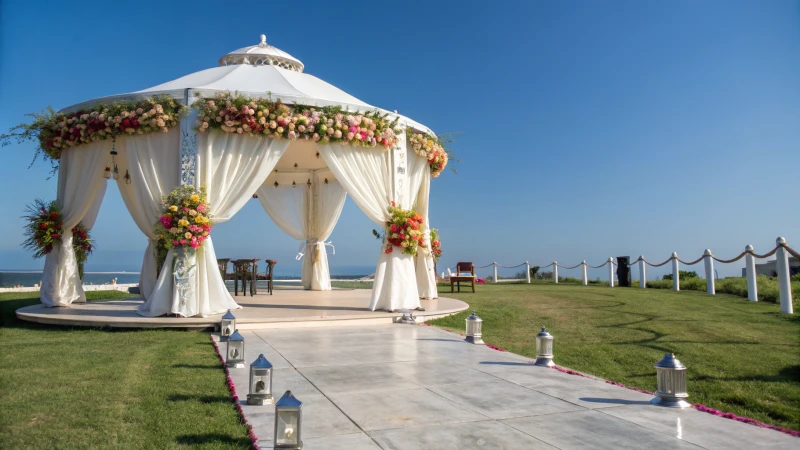
Understanding Expandable Bolts for Tent Security
I remember standing in the middle of an open field, my heart racing as I envisioned guests scattering in all directions, chasing after the flying wedding tent. That was before I discovered the magic of expandable bolts. These clever little devices are a lifesaver when you’re dealing with concrete surfaces. They work by expanding inside a drilled hole to secure a firm grip—almost like a giant hand holding your tent in place.
| Features | Advantages |
|---|---|
| High tensile strength | Ensures tent stability |
| Easy installation | Quick setup without fuss |
| Removable | Suitable for temporary events |
Factors to Consider When Using Expandable Bolts
Before you start, take a good look at your venue’s surface3. If it’s concrete, you’re in luck! If not, you might need a plan B. Think about the weather forecast and the size of your tent too. Installing these bolts is straightforward: drill a hole, insert the bolt, and tighten it until it’s snug and secure. Just make sure your drill bit matches the bolt size—you want everything to fit just right.
Alternatives When Expandable Bolts Aren’t Feasible
I once had a wedding at a beautiful old hotel that wouldn’t let me drill into their historic grounds. Weight plates came to the rescue! They’re perfect for places where you can’t make holes, like historical sites or chic hotels. These plates keep everything steady without leaving a mark, making them a brilliant alternative for long-term setups too. Always have a backup plan—it’s your special day, and peace of mind is priceless.
Consider using weight plates4 if your venue has specific restrictions on ground penetration or if you anticipate adverse weather conditions that require additional security measures for your tent setup.
Expandable bolts are suitable for all surfaces.False
Expandable bolts are ideal for concrete, not all surfaces.
Weight plates are an alternative to expandable bolts.True
Weight plates provide stability without ground penetration.
Why Choose Weight Plates Over Other Equipment?
Have you ever felt overwhelmed by the sheer variety of gym equipment?
Opt for weight plates when you need versatility in your workouts, allowing for customizable weight adjustments. They’re perfect for exercises like powerlifting and Olympic lifting, offering flexibility across different routines.
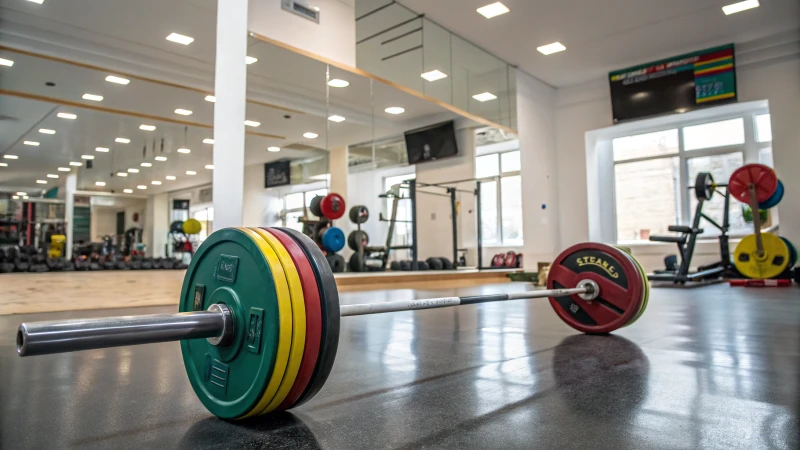
Understanding the Versatility of Weight Plates
I remember the first time I ventured into the weight section of the gym; the sight was both exciting and intimidating. There were so many options! But it was the versatility of weight plates that caught my attention. Whether you’re a powerlifting5 enthusiast or into Olympic lifting, these plates let you adjust weights easily, making them indispensable for anyone who likes to mix up their workouts.
Comparing Weight Plates to Dumbbells and Kettlebells
| Equipment | Adjustability | Range of Motion | Cost-Effectiveness |
|---|---|---|---|
| Weight Plates | High | Moderate | High |
| Dumbbells | Low | High | Moderate |
| Kettlebells | Low | High | Moderate |
Reflecting on my own fitness journey, I realize how crucial flexibility is in maintaining motivation. Weight plates offer that high adjustability, allowing me to tailor my workout based on how I’m feeling that day or the specific goals I’m chasing.
Specific Scenarios for Using Weight Plates
-
Home Gym Setup6: When I was setting up my home gym, space was at a premium. Weight plates turned out to be perfect because they are compact and can be used with a barbell or even on their own for various exercises.
-
Rehabilitation and Recovery: During recovery from an injury, I found that weight plates were ideal. They allow for gradual weight increments, which helped me rebuild strength safely and progressively.
-
Training Variability7: As someone who gets bored easily, being able to switch up my workouts is a must. Weight plates provide the variability needed to target different muscle groups and keep things interesting.
The Importance of Material and Design
Choosing the right weight plates is more than just about weight; it’s also about material. Metal plates are incredibly durable but can be unforgiving on floors. Bumper plates, on the other hand, have a rubber coating that’s great for dynamic lifts, especially if you’re into Olympic lifts8 and tend to drop weights often.
Understanding these factors helps in selecting equipment that aligns with fitness goals while ensuring safety and effectiveness. Whether you’re just starting out or you’re a seasoned pro, weight plates can be a game-changer in your fitness routine.
Weight plates offer high adjustability in workouts.True
Weight plates allow for easy weight changes, providing workout flexibility.
Kettlebells are more cost-effective than weight plates.False
Weight plates are noted for their cost-effectiveness compared to kettlebells.
What other factors should you consider when choosing a tent?
Imagine you’re deep in the woods, and your tent is your only protection against the elements. Making the right choice is crucial.
When choosing a tent, consider factors like weather resistance, ease of setup, and ventilation. These elements ensure comfort and safety during your camping trip, providing a reliable shelter regardless of conditions.

Weather Resistance
I remember one camping trip where it poured down rain the entire weekend. Thankfully, my tent held up like a champ because I had chosen one with a high hydrostatic head rating9. This rating meant it was equipped to handle a lot of water, keeping us dry and cozy inside. A robust rainfly and taped seams are must-haves if you’re venturing into wet climates. And if you’re braving windy or snowy conditions, make sure to check the tent’s wind resistance and snow load ratings too.
Ease of Setup
There’s nothing quite as frustrating as wrestling with a complicated tent after a long drive to the campsite. On my first solo camping trip, I learned this the hard way. Nowadays, I look for features like color-coded poles and clips that make setup intuitive. Some tents even have quick-pitch designs that are a lifesaver when bad weather is brewing. Practicing at home is a pro tip—trust me, you’ll feel like a camping superhero when you can pitch your tent in record time.
| Feature | Benefit |
|---|---|
| Color-coded poles | Simplifies setup process |
| Quick-pitch design | Reduces setup time, ideal for sudden weather changes |
Ventilation
Waking up in a damp tent with condensation dripping on your face is not fun. That’s why I always check for good ventilation features. Tents with multiple vents or mesh panels allow airflow while keeping those pesky bugs out. Some models even have adjustable vents, which I find perfect for tailoring airflow to whatever the weather throws at me.
Tent Material
Choosing the right material can really make or break your camping experience. I often go for nylon when I’m backpacking since it’s super lightweight. But for longer trips in sunny areas, polyester is my go-to because it’s more UV resistant and durable.
| Material | Durability | Weight |
|---|---|---|
| Nylon | Moderate | Lightweight |
| Polyester | High | Moderate |
Additional Features
Over time, I’ve come to appreciate little extras like gear lofts and interior pockets—they make organizing gear so much easier! Plus, reflective guylines are a game changer for those inevitable midnight bathroom runs; they help me avoid tripping over in the dark.
Understanding these factors can transform your camping adventures from stressful to serene. For more details on weather-resistant tents10, be sure to explore further resources online.
High hydrostatic head ratings indicate better water resistance.True
Hydrostatic head measures water resistance; higher ratings mean better protection.
Polyester tents are generally lighter than nylon tents.False
Nylon is lighter, making it more suitable for backpacking than polyester.
Conclusion
Learn how to securely set up a wedding tent on concrete using steel anchors, expandable bolts, or weight plates, ensuring stability and aesthetic appeal for your special day.
-
Explore the engineering principles behind steel anchors’ tensile strength to understand their application better. ↩
-
Learn how to select the best anchor for your project based on material, environment, and load requirements. ↩
-
Discover which surfaces are suitable for expandable bolts and what alternatives exist for less common grounds. ↩
-
Learn how weight plates can stabilize tents without drilling, ideal for long-term events. ↩
-
Explore why weight plates are favored in powerlifting, highlighting their role in adjustable weight training. ↩
-
Learn about the advantages of using weight plates in a home gym environment, focusing on their space efficiency and versatility. ↩
-
Discover how weight plates support diverse training routines by offering varied exercise options. ↩
-
Understand the specific benefits of using bumper plates during Olympic lifts, emphasizing safety and performance. ↩
-
Explore this link to understand how hydrostatic head ratings determine a tent’s water resistance. ↩
-
Discover top-rated weather-resistant tents that withstand various conditions, ensuring comfort and safety. ↩



